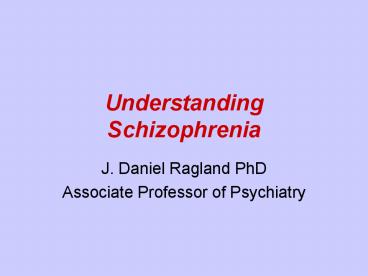Understanding Schizophrenia - PowerPoint PPT Presentation
1 / 25
Title:
Understanding Schizophrenia
Description:
Behavioral syndrome - positive and negative symptoms. Onset ... Prodrome. onset. Early. development. Adolescence. Premorbid. phase. Prepsychotic. phase. First ... – PowerPoint PPT presentation
Number of Views:267
Avg rating:3.0/5.0
Title: Understanding Schizophrenia
1
Understanding Schizophrenia
- J. Daniel Ragland PhD
- Associate Professor of Psychiatry
2
Clinical Features
- Brain disorder - impairs ability to perceive,
understand and interpret the environment. 1
worldwide. - Impaired function - social and motivational
- Behavioral syndrome - positive and negative
symptoms - Onset in late teens to early 20s
- Unremitting course with later onset better
outcome for women - Genetically complex - like heart disease
- Genetic environmental factors
- Multiple genes with variable penetrance
3
Symptoms
- At least 4 weeks of 2 of the following
- Hallucinations
- Delusions
- Negative symptoms
- Disorganization
- Minimum duration of 6 months of continuous signs
of illness - Functional decline!
4
Clinical Course
First
Relapses
episode
Residual
Prepsychotic
phase
phase
Premorbid
phase
10
15
20 25
Age
Prodrome
First
onset
Early
development
treatment
Untreated illness
Adolescence
Keshavan
5
Heterogeneity of Schizophrenia
- Symptom diversity
- DSM subtypes paranoid, undifferentiated,
disorganized, catatonic - Other typologies type I and type II (Crow),
deficit and non deficit (Carpenter) - People have increasingly tried to understand
symptoms rather than the disorder itself
6
Epidemiology
- 1 of population world wide
- Males and females equally affected but females
have later onset and better functional outcome - Onset in late adolescence, early adulthood
- Loss of function, inability to achieve expected
function - 10 SSI/SSDI, 2 GNP in direct care costs and
lost productivity
7
Genetics
- Highly heritable
- Risk increases with relationship e.g. 10 for
first degree relative or fraternal twin, 50
concordance for monozygotic twin - Environmental factors certain but poorly
characterized (intrauterine malnutrition, viral
illnesses, perinatal insults, drug exposure)
8
Genetic Risk
9
Genetic Association
10
(Endo)Phenotypes
Affectation status reflects an underlying
quantitative trait liability, susceptibility,
risk of developing disease.
Discrete
Continuous
(disease)
(liability)
0
1
t
11
Causes of Schizophrenia
- Risk gene/environment interactions
- Altered neurodevelopment leading to symptoms in
early adolescence/young adulthood - Gross structural changes in the brain
- Specific functional changes in the brain
- Alterations in local circuit architecture
- Alterations in dopamine neurotransmission
12
Gross Pathology
n63 Age 78.3 (SD9.7, Range 67 - 99) Brain
Weight 1192 g (SD143, Range 932 - 1520) PMI
12.6 hrs (SD4.9, Range 932 - 1520) Diagnoses
Normal brain 45 Alzheimers disease 5
Lewy body variant AD 1 Parkinsons
disease 2 Cerebrovascular lesions 6
Meningioma 2 Metastatic adenocarcinoma
(lung) 1 Adult polyglucosan body disease 1
13
Neurodegenerative Lesions
PHFtau NFTs
Ab SPs
Arnold et al., 1998
14
Neuron Density and Size
Arnold et al., 1995
15
Entorhinal Cytoarchitecture
1.4 1.0 0.6
N S
Dispersion Index
40 20 0
N S
Arnold et al., 1997
Effective Radius
16
Molecular Components of Structural Plasticity
Axons Terminals Dendrites Spines
LTP
Synapsin-1 Synaptophysin SNAP25
VGluT-1 VGaT GAP43
NCAM Dysbindin
b-Dystrobrevin
Homer pGluR pNMDAR1
N-cadherin pCamKII Rim 1
Homer MAP2 NFM/H-P-
Synaptopodin F-actin Drebrin EphA4
17
(No Transcript)
18
Specific functional changes in the brain
Right BA 9
Left BA 10/46
Dis. Sx in Patients r-.55, plt.005
Dis. Sx in Patients r-.40, plt.05
Neg. Sx in Patients r-.46, plt.01
- FE Schiz
- FE Other Psych
19
Alterations in dopamine neurotransmission
- The classical dopamine hypothesis (too much
dopamine in schizophrenia) rested on the
observation that DA releasing drugs can cause
psychosis, and the discovery that antipsychotics
were dopamine antagonists.
20
Alterations in dopamine neurotransmission
- C11 Racolpride displacement reflects DA release
21
Increased subcortical DA related to psychosis
22
Alterations in dopamine neurotransmission
- Decreased prefrontal activity may lead to
subcortical DA dysregulation and psychosis
Decreased PFC function
Increased DA
VTA
23
Progressive Neuro- developmental Model
Keshavan
24
Management of Schizophrenia
- Early intervention important for improving
functional outcome - Medication treatments
- Psychosocial Treatments
25
Future Directions in the Treatment of
Schizophrenia
- More optimistic view of outcome
- Much stronger focus on early intervention and
prevention e.g. early psychosis clinics and
prodromal studies - Specific treatments for cognition in
schizophrenia - As molecular pathways associated with neural
phenotypes become understood new, non dopamine
based therapies - Renewed emphasis on rehabilitation, supported
employment etc.































